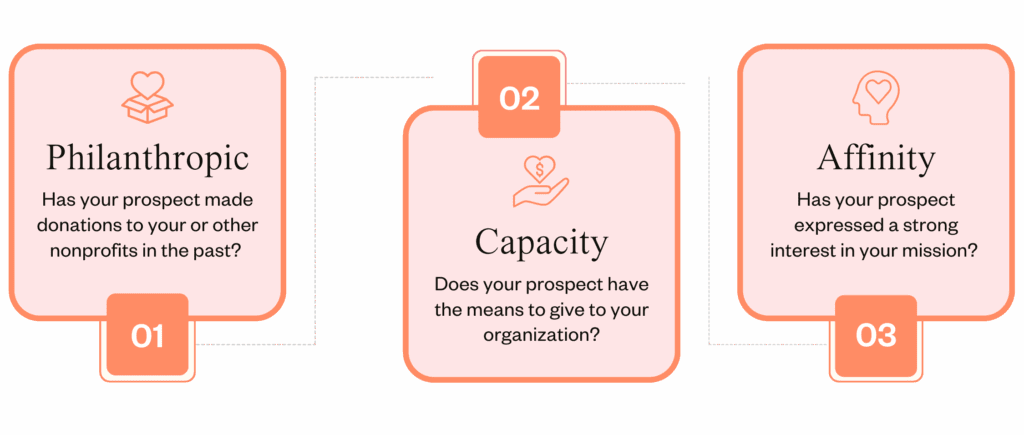
Sometimes, building relationships with potential donors happens organically for nonprofits. Perhaps a board member brings a plus one to a fundraising event, and they later express an interest in learning more. In this instance, sharing your recent accomplishments and offering opportunities for involvement before you request a donation might come as second nature.
But this is all part of a strong donor cultivation practice—a strategic way to deepen relationships with potential supporters before you make a fundraising ask.
Below, we’ll explore donor cultivation basics, how it can benefit your nonprofit, and share donor cultivation best practices—so you can increase your revenue and build relationships that go deeper than just one donation.
What is donor cultivation?
Donor cultivation refers to the strategies a nonprofit uses to build strong relationships with supporters before requesting a donation.
Often, donor cultivation involves sharing information about your organization and getting to know your supporters. This could be through social media, in-person events, direct mail, or telephone calls. An effective donor cultivation strategy typically incorporates several forms of communication.
The benefits of donor cultivation
When you’ve spent time thoughtfully laying the groundwork for strong supporter relationships, you’re much more likely to be successful when you do make a monetary request.
Raising money for your mission is typically the main goal of donor cultivation, but it’s not the only benefit:
- Learn about your supporters: Getting to know your supporters at a deeper level helps you make informed decisions about your nonprofit programming and development. You’ll show your supporters they’re valued, and in turn, they can help you stay true to your mission.
- Set your nonprofit up for steady growth: Viewing donor engagement as part of a larger fundraising cycle and not just a series of one-off asks helps fuel steady growth. This leads to increased nonprofit resilience.
- Increase donor retention rates: Thoughtful donor cultivation makes it more likely that your supporters will be able to give beyond one donation.
- Build trust and brand recognition: Nonprofit donor cultivation helps increase visibility, which in turn builds familiarity and trust. 93% of nonprofits believe that strong branding leads to increased donor engagement.
- Encourage donors to become advocates: Supporters who feel a deeper sense of connection to your mission are more likely to stay loyal to your cause. They may even share your mission with their families and friends, helping to expand your reach.
What is the donor cultivation cycle?
The donor cultivation cycle is made up of four different stages. Below, we’ll explore what each of these stages involves and how to strengthen relationships at each stage.
Stage 1: Identification
Identification is the process of strategically analyzing your support base to determine those most likely to give. This stage is also referred to as donor prospecting.
Three indicators determine how likely a supporter is to make a donation:

- Philanthropic indicators: Has your prospect made donations to your nonprofit or other nonprofits in the past?
- Capacity indicators: Does your prospect have the means to give to your organization? Real estate ownership, business affiliations, or evidence of prior political giving can all be good indicators of this.
- Affinity indicators: Has your prospect expressed a strong interest in your mission? Evaluate if there’s a history of involvement with your nonprofit, or consider any personal information your prospect has shared to help gauge this.
A supporter with all three of these indicators is a likely candidate for giving.
With powerful prospecting tools like advanced analytics and AI-powered prospect lists, donor software such as Kindsight helps make your donor cultivation process more focused and efficient.
Stage 2: Cultivation
Donor cultivation is the process of getting to know your prospects after initial contact with your organization through relationship building. During this period, it’s important to create non-momentary opportunities for involvement in your organization.
Donor cultivation ideas include offering volunteering opportunities, sharing a newsletter signup, or inviting your new supporters to events.
This is often the longest phase of the cycle, but investing in a thoughtful donor cultivation process comes with significant long-term payoffs for your organization. Don’t underestimate the power of non-monetary involvement when it comes to building trust and loyalty—for example, research shows 79% of supporters who volunteered with an organization had a more positive view of it after the experience.
Stage 3: Solicitation
The solicitation phase is when you finally make your monetary ask. Tailor your ask and communication method based on your prospect’s capacity. For example, if your prospect shows significant capacity indicators and you’re requesting a large gift, it’s best to do so in person.
Stage 4: Stewardship
Donor stewardship refers to the process of keeping your supporters invested in your mission after they’ve made their first donation. The first, essential step of successful donor stewardship is sending your supporters a thank you letter immediately after they donate.
From here, your donor stewardship may include sharing impact reports, hosting donor appreciation events, and sharing beneficiary spotlights. The goal is to deepen relationships with your donor base through considered, personalized communications and more opportunities for deeper engagement.
Sample donor cultivation plan template
For many nonprofits, one of the most challenging aspects of donor cultivation is time management. You might want to spend time engaging deeply with every one of your supporters, but unfortunately, this isn’t always practical or possible.
To keep things simple, create a donor cultivation plan ahead of time. This way, you’ll easily be able to view each of your cultivation activities, when they should be completed, and which member of your team is responsible for completing them.
The template below can be modified to help you create your donor cultivation plan.
Donor cultivation plan template by month
| Month | Donor cultivation activity | Audience | Team member responsible |
| January | Invitations to volunteer at the annual spring fundraiser | Engaged mid-level donors | Communications coordinator |
| February | Phone call-check in | Prospective high-ticket donors | Developmental director |
| March | Share beneficiary impact story via email | Engaged mid-level prospects | Communications coordinator |
| April | Annual spring fundraiser | All supporters and donors | Entire team |
| May | “Thank you for attending fundraiser” postcards | Spring fundraiser volunteers and attendees | Communications coordinator |
| June | Educational conference lunch | Engaged mid-level prospects | Developmental director |
| July | Coffee check-in and chat | Prospective high-ticket donors | Founder or major gifts officer |
| August | Meeting to make fundraising asks | Prospective high-ticket donors | Founder or the major gifts office |
| September | Behind-the-scenes facility tour | Prospective high-ticket donors | Board member or founder |
| October | Educational webinar | Engaged mid-level prospects | Developmental director |
| November | Annual impact report | Engaged mid-level prospects | Developmental director |
| December | Holiday Cards | All supporters and prospective donors | Communications coordinator |
Donor cultivation plan template by giving tier
Depending on your prospect’s capacity to give, your donor cultivation efforts should look different, and it can also be useful to plan out donor cultivation activities by giving tier.
For example, offering a personal facility tour to a supporter who regularly gives a small donation may not be necessary. Equally, requesting a significant donation amount from a supporter who’s received only a few emails or texts may leave a bad impression. The example below can be edited to fit your organization’s needs.
| Giving tier | Donor cultivation activity | Frequency of activity |
| Tier 1: High ticket donors | Personal phone call with founderIn-person lunch Private facility tourShare impact reports Personal event invitationsShare personalized information (articles or events based on interest) | 4 per year (including 2 phone calls) |
| Tier 2: Medium-gift donors | Personal phone call with developmental offerInvitation to an educational event or conferenceInvitation to volunteer at an eventShare impact reports“Thank you” postcards | 4 per year (including 1 phone call) |
| Tier 3: Smaller gift donors | Personal phone call with volunteer or other member of your nonprofitHoliday cards“Thank you” postcardsShare beneficiary spotlights via emailShare a survey to learn more about their interestsInvitation to participate in fundraising eventsEmail updatesThank you texts | 3 pear year (including 1 phone call) |
Donor cultivation strategies and best practices
Conduct thorough prospect research
Prospect research is the foundation of any successful nonprofit cultivation strategy. The more you know about your supporters’ experiences, the more you’ll be able to personalize your outreach to fit their interests.
If you’re looking to make a significant ask, it’s especially important you review and analyze these key indicators. You’ll want to make sure your prospect is likely willing and able to agree to your ask before you invest time and energy in donor cultivation.
Track progress
Keep track of how supporters respond to each of your donor cultivation activities. Adapt your strategy as needed to focus on the most successful activities. Keep your timeline flexible—if someone expresses interest in donating earlier than you expect, don’t wait to make the ask.
Focus on tangible impact
Your supporters want to know how their contributions will make a difference to your organization and your beneficiaries’ lives. Keep your focus on tangible impact to build trust. Supporters are more likely to give if they have a clear idea of how their contributions will advance your mission.
For example, if you were recently able to build a new educational facility thanks to money raised at a recent fundraising event, let them know.
Build up online presence
Establish your organization as credible and trustworthy with a strong online presence, including an easy-to-navigate website and social media. Make it as easy as possible for interested supporters to find additional information on your nonprofit.
Remember the details
Remembering small, thoughtful details about your supporters goes a long way. If a supporter lets you know about an aspect of your mission they’re particularly interested in, personally share an industry update via text. If someone mentions in passing they’re going on a trip, ask about it when they return. Interactions like this help foster genuine connections.
Use the right tools
Strong donor prospecting tools are an essential part of any effective donor cultivation strategy. With the right tools, you can identify supporters most likely to become donors and channel your cultivation efforts in the right direction.
Kindsight offers prospecting tools such as philanthropy screening, insights into prospect affinity, and live profiles that update in real time so you can keep track of your prospects.
Conclusion
Ultimately, effective donor cultivation is more about developing regular, thoughtful communication cadences with your supporters. A donor cultivation plan can help you determine which types of cultivation activities you’ll use and when.
Securing a high-ticket donor can take years of donor cultivation. But a good donor cultivation practice helps increase donor loyalty and can help prevent lapsed donors. Typically, consistency and quality of communication are more important than volume.
Donor cultivation FAQs
What does it mean to cultivate donors?
Cultivating donors refers to the process of building a relationship with your supporters before you make a monetary ask. Donor cultivation usually consists of different outreach activities spread out over a period of time. These activities can include phone calls, invitations to volunteer, email, texts, or handwritten letters.
What is the difference between donor stewardship and donor cultivation?
Donor cultivation refers to the steps nonprofits take to foster relationships with prospective donors before they ask for donations. Donor stewardship refers to the way nonprofits nurture these relationships after a supporter has already donated.
How long does it take to cultivate a major donor?
There’s no hard and fast rule on how long it takes to cultivate a high-ticket donor. In some cases, it may just take a few months. In other cases, it can take years of following up with warm leads before a supporter becomes a major donor. Conversion time may be shorter if you’re running a fundraising campaign with a set deadline.
What are the 5 stages of donor development?
The five stages of the donor development cycle (sometimes called the fundraising cycle) are identification, cultivation, solicitation, stewardship, and renewal. These five stages provide a framework for nonprofits to manage donor relationships at every stage of the donor journey—all the way from someone making initial contact with an organization to that person becoming a lifelong supporter.
Be the first to read our resources.
The world is changing quickly—and our resources help you stay on top of it all. Sign up to get new insights, success stories, and more, sent right to your inbox.




